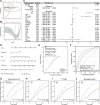A model based on PT-INR and age serves as a promising predictor for evaluating mortality risk in patients with SARS-CoV-2 infection
- PMID: 40248368
- PMCID: PMC12003402
- DOI: 10.3389/fcimb.2025.1499154
A model based on PT-INR and age serves as a promising predictor for evaluating mortality risk in patients with SARS-CoV-2 infection
Abstract
COVID-19 caused by the coronavirus SARS-CoV-2 has resulted in a global pandemic. Considering some patients with COVID-19 rapidly develop respiratory distress and hypoxemia, early assessment of the prognosis for COVID-19 patients is important, yet there is currently a lack of research on a comprehensive multi-marker approach for disease prognosis assessment. Here, we utilized a large sample of hospitalized individuals with COVID-19 to systematically compare the clinical characteristics at admission and developed a nomogram model that was used to predict prognosis. In all cases, those with pneumonia, older age, and higher PT-INR had a poor prognosis. Besides, pneumonia patients with older age and higher PT-INR also had a poor prognosis. A nomogram model incorporating presence of pneumonia, age and PT-INR could evaluate the prognosis in all patients with SARS-CoV-2 infections well, while a nomogram model incorporating age and PT-INR could evaluate the prognosis in those with pneumonia well. Together, our study establishes a prognostic prediction model that aids in the timely identification of patients with poor prognosis and helps facilitate the improvement of treatment strategies in clinical practice in the future.
Keywords: PT-INR; SARS-CoV-2; age; mortality; predictor.
Copyright © 2025 Xu, Tang, Guo, Lin, Guo, Fang, Lin, Shi, Lai, Pan, Tang, You, Li, Song, Wang, Cai and Fu.
Conflict of interest statement
The authors declare that the research was conducted in the absence of any commercial or financial relationships that could be construed as a potential conflict of interest.
Figures




References
MeSH terms
LinkOut - more resources
Full Text Sources
Medical
Miscellaneous

